Higher National Diploma Business Report: Organisational Analysis
VerifiedAdded on 2022/04/07
|9
|2556
|394
Report
AI Summary
This report examines various organisational types, including voluntary, public, and private enterprises, and analyzes their purposes, scopes, and sizes. It explores the legal structures of Tesco, Virgin Money, and Cancer Research UK, providing a comparative analysis of micro, small, and large/medium enterprises. The report delves into the interrelationship between different organisational functions, such as marketing, human resource management, finance, and operations management. It also analyzes the positive and negative impacts of the macro environment on Virgin Money through a PESTEL analysis and a SWOT analysis. Furthermore, the report utilizes a TOWS matrix to identify the interrelation of strengths and weaknesses, opportunities, and threats, providing a comprehensive overview of the business environment and strategic considerations.
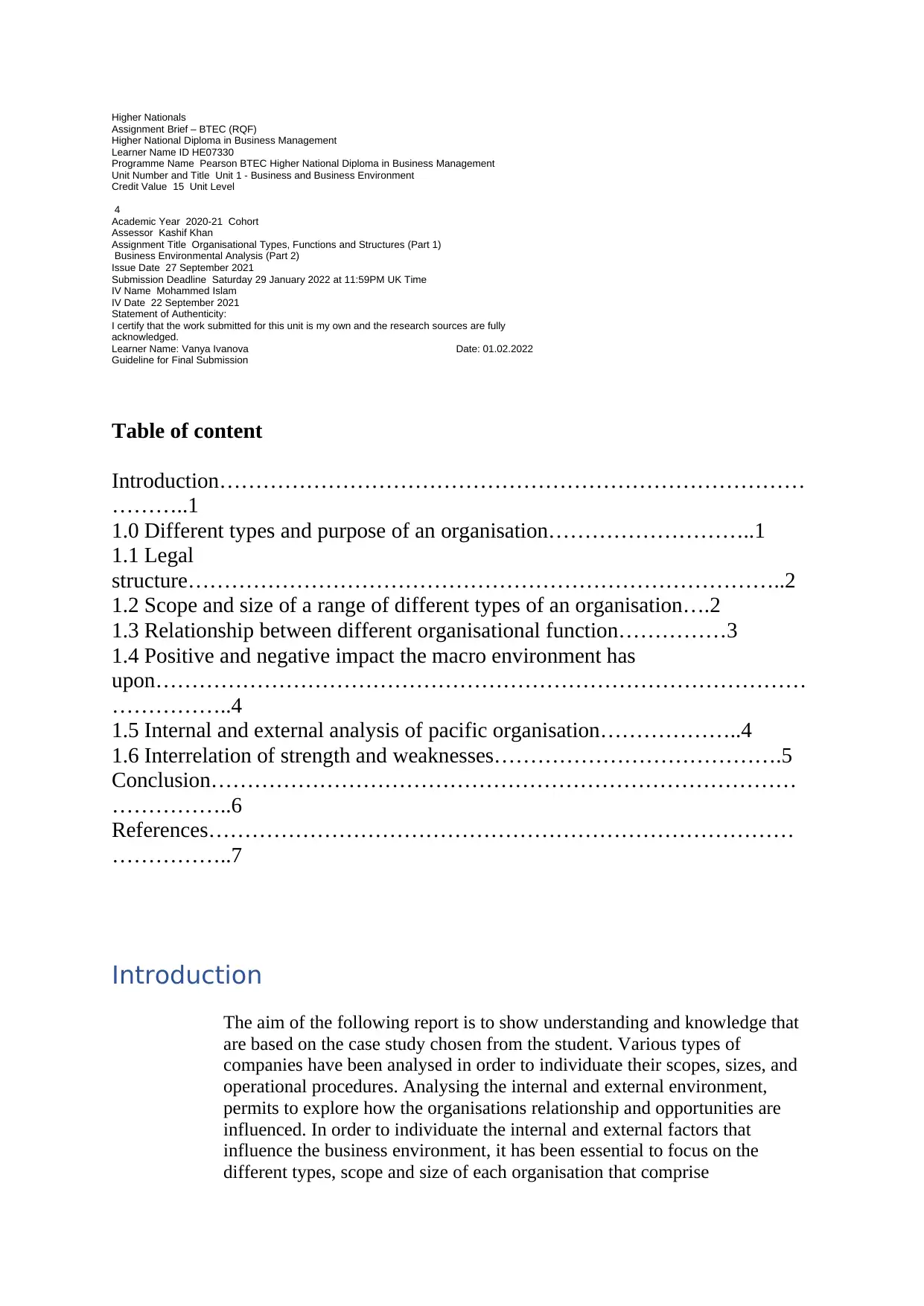
Higher Nationals
Assignment Brief – BTEC (RQF)
Higher National Diploma in Business Management
Learner Name ID HE07330
Programme Name Pearson BTEC Higher National Diploma in Business Management
Unit Number and Title Unit 1 - Business and Business Environment
Credit Value 15 Unit Level
4
Academic Year 2020-21 Cohort
Assessor Kashif Khan
Assignment Title Organisational Types, Functions and Structures (Part 1)
Business Environmental Analysis (Part 2)
Issue Date 27 September 2021
Submission Deadline Saturday 29 January 2022 at 11:59PM UK Time
IV Name Mohammed Islam
IV Date 22 September 2021
Statement of Authenticity:
I certify that the work submitted for this unit is my own and the research sources are fully
acknowledged.
Learner Name: Vanya Ivanova Date: 01.02.2022
Guideline for Final Submission
Table of content
Introduction………………………………………………………………………
………..1
1.0 Different types and purpose of an organisation………………………..1
1.1 Legal
structure………………………………………………………………………..2
1.2 Scope and size of a range of different types of an organisation….2
1.3 Relationship between different organisational function……………3
1.4 Positive and negative impact the macro environment has
upon………………………………………………………………………………
……………..4
1.5 Internal and external analysis of pacific organisation………………..4
1.6 Interrelation of strength and weaknesses………………………………….5
Conclusion………………………………………………………………………
……………..6
References………………………………………………………………………
……………..7
Introduction
The aim of the following report is to show understanding and knowledge that
are based on the case study chosen from the student. Various types of
companies have been analysed in order to individuate their scopes, sizes, and
operational procedures. Analysing the internal and external environment,
permits to explore how the organisations relationship and opportunities are
influenced. In order to individuate the internal and external factors that
influence the business environment, it has been essential to focus on the
different types, scope and size of each organisation that comprise
Assignment Brief – BTEC (RQF)
Higher National Diploma in Business Management
Learner Name ID HE07330
Programme Name Pearson BTEC Higher National Diploma in Business Management
Unit Number and Title Unit 1 - Business and Business Environment
Credit Value 15 Unit Level
4
Academic Year 2020-21 Cohort
Assessor Kashif Khan
Assignment Title Organisational Types, Functions and Structures (Part 1)
Business Environmental Analysis (Part 2)
Issue Date 27 September 2021
Submission Deadline Saturday 29 January 2022 at 11:59PM UK Time
IV Name Mohammed Islam
IV Date 22 September 2021
Statement of Authenticity:
I certify that the work submitted for this unit is my own and the research sources are fully
acknowledged.
Learner Name: Vanya Ivanova Date: 01.02.2022
Guideline for Final Submission
Table of content
Introduction………………………………………………………………………
………..1
1.0 Different types and purpose of an organisation………………………..1
1.1 Legal
structure………………………………………………………………………..2
1.2 Scope and size of a range of different types of an organisation….2
1.3 Relationship between different organisational function……………3
1.4 Positive and negative impact the macro environment has
upon………………………………………………………………………………
……………..4
1.5 Internal and external analysis of pacific organisation………………..4
1.6 Interrelation of strength and weaknesses………………………………….5
Conclusion………………………………………………………………………
……………..6
References………………………………………………………………………
……………..7
Introduction
The aim of the following report is to show understanding and knowledge that
are based on the case study chosen from the student. Various types of
companies have been analysed in order to individuate their scopes, sizes, and
operational procedures. Analysing the internal and external environment,
permits to explore how the organisations relationship and opportunities are
influenced. In order to individuate the internal and external factors that
influence the business environment, it has been essential to focus on the
different types, scope and size of each organisation that comprise
Paraphrase This Document
Need a fresh take? Get an instant paraphrase of this document with our AI Paraphraser
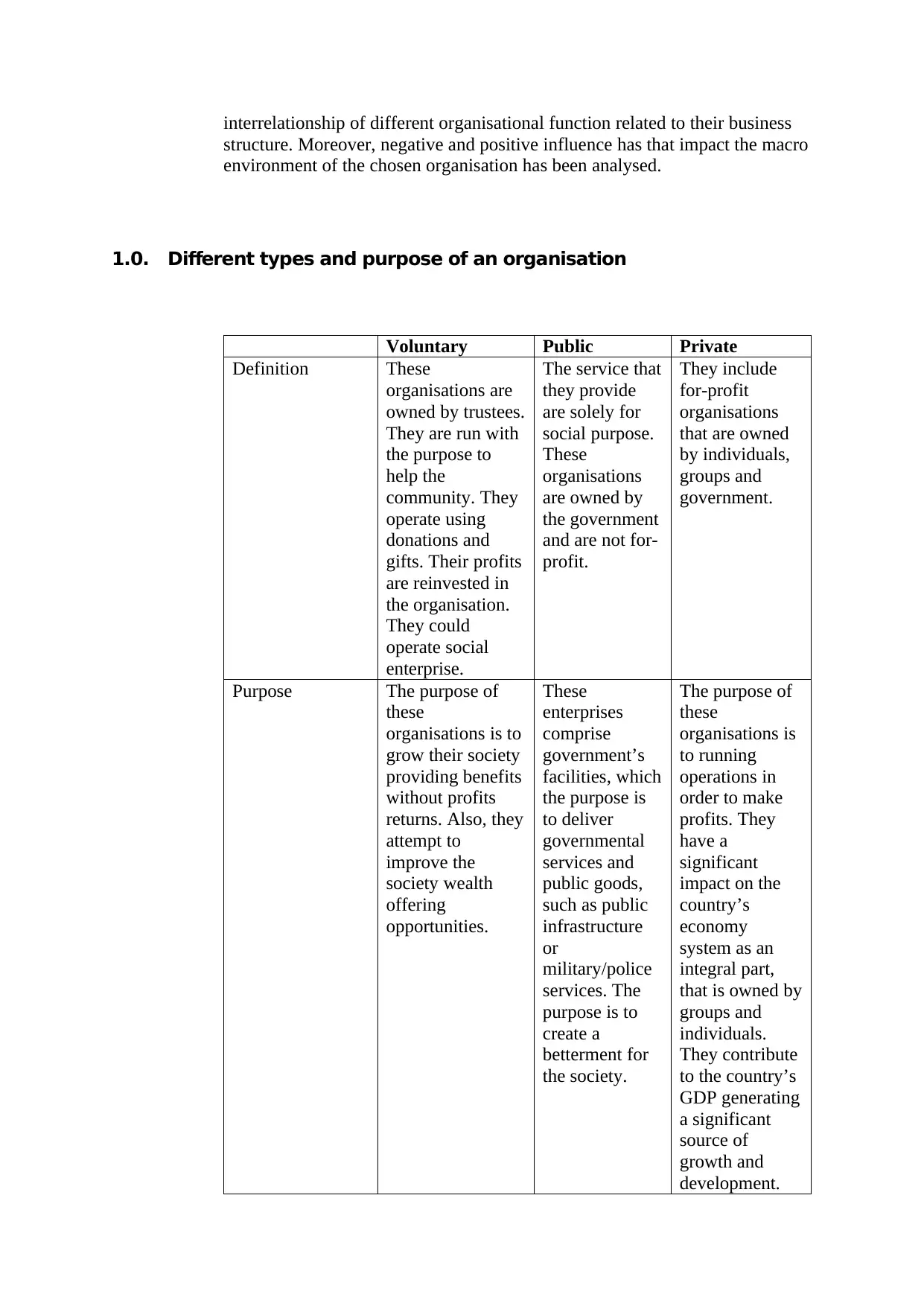
interrelationship of different organisational function related to their business
structure. Moreover, negative and positive influence has that impact the macro
environment of the chosen organisation has been analysed.
1.0. Different types and purpose of an organisation
Voluntary Public Private
Definition These
organisations are
owned by trustees.
They are run with
the purpose to
help the
community. They
operate using
donations and
gifts. Their profits
are reinvested in
the organisation.
They could
operate social
enterprise.
The service that
they provide
are solely for
social purpose.
These
organisations
are owned by
the government
and are not for-
profit.
They include
for-profit
organisations
that are owned
by individuals,
groups and
government.
Purpose The purpose of
these
organisations is to
grow their society
providing benefits
without profits
returns. Also, they
attempt to
improve the
society wealth
offering
opportunities.
These
enterprises
comprise
government’s
facilities, which
the purpose is
to deliver
governmental
services and
public goods,
such as public
infrastructure
or
military/police
services. The
purpose is to
create a
betterment for
the society.
The purpose of
these
organisations is
to running
operations in
order to make
profits. They
have a
significant
impact on the
country’s
economy
system as an
integral part,
that is owned by
groups and
individuals.
They contribute
to the country’s
GDP generating
a significant
source of
growth and
development.
structure. Moreover, negative and positive influence has that impact the macro
environment of the chosen organisation has been analysed.
1.0. Different types and purpose of an organisation
Voluntary Public Private
Definition These
organisations are
owned by trustees.
They are run with
the purpose to
help the
community. They
operate using
donations and
gifts. Their profits
are reinvested in
the organisation.
They could
operate social
enterprise.
The service that
they provide
are solely for
social purpose.
These
organisations
are owned by
the government
and are not for-
profit.
They include
for-profit
organisations
that are owned
by individuals,
groups and
government.
Purpose The purpose of
these
organisations is to
grow their society
providing benefits
without profits
returns. Also, they
attempt to
improve the
society wealth
offering
opportunities.
These
enterprises
comprise
government’s
facilities, which
the purpose is
to deliver
governmental
services and
public goods,
such as public
infrastructure
or
military/police
services. The
purpose is to
create a
betterment for
the society.
The purpose of
these
organisations is
to running
operations in
order to make
profits. They
have a
significant
impact on the
country’s
economy
system as an
integral part,
that is owned by
groups and
individuals.
They contribute
to the country’s
GDP generating
a significant
source of
growth and
development.
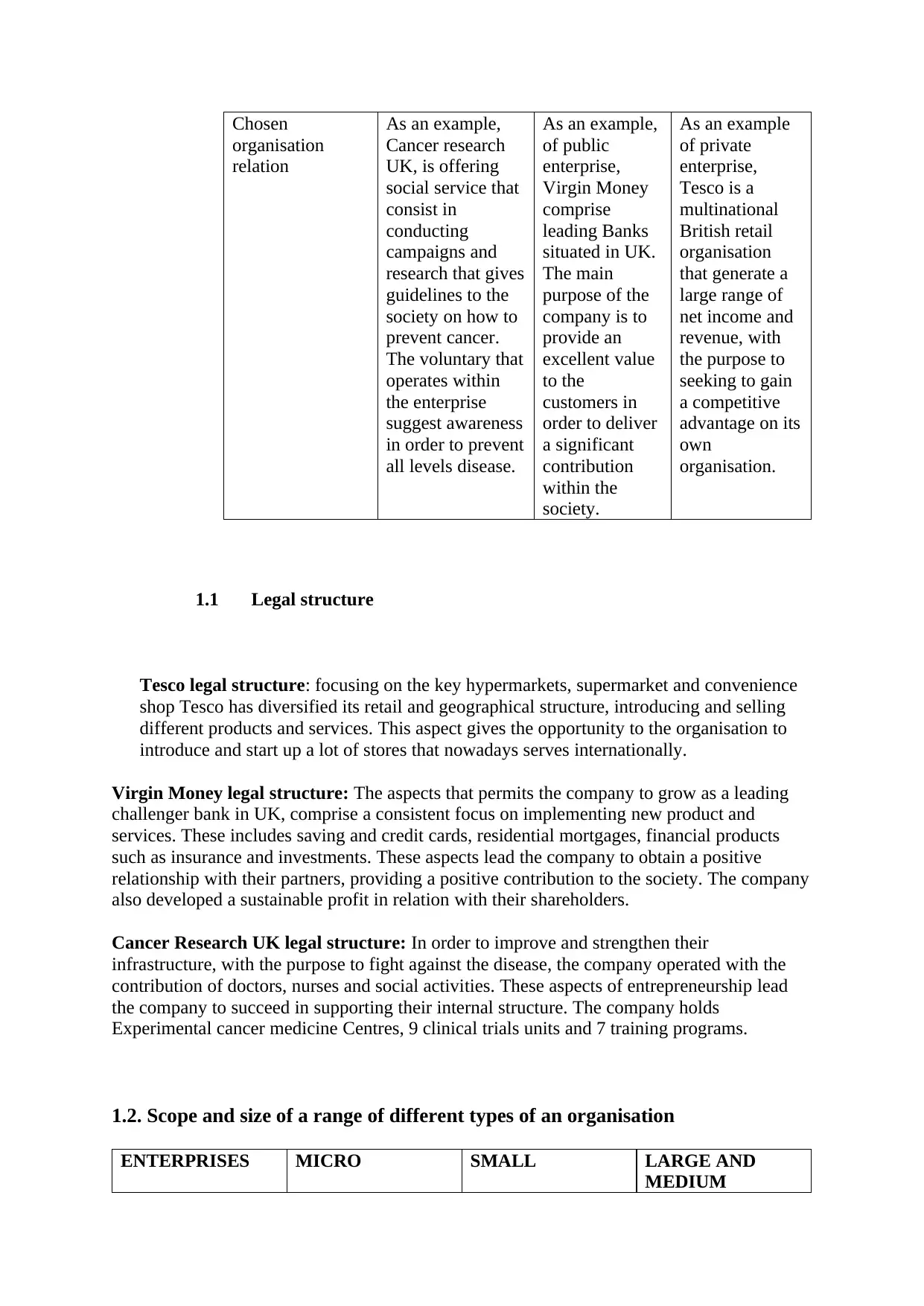
Chosen
organisation
relation
As an example,
Cancer research
UK, is offering
social service that
consist in
conducting
campaigns and
research that gives
guidelines to the
society on how to
prevent cancer.
The voluntary that
operates within
the enterprise
suggest awareness
in order to prevent
all levels disease.
As an example,
of public
enterprise,
Virgin Money
comprise
leading Banks
situated in UK.
The main
purpose of the
company is to
provide an
excellent value
to the
customers in
order to deliver
a significant
contribution
within the
society.
As an example
of private
enterprise,
Tesco is a
multinational
British retail
organisation
that generate a
large range of
net income and
revenue, with
the purpose to
seeking to gain
a competitive
advantage on its
own
organisation.
1.1 Legal structure
Tesco legal structure: focusing on the key hypermarkets, supermarket and convenience
shop Tesco has diversified its retail and geographical structure, introducing and selling
different products and services. This aspect gives the opportunity to the organisation to
introduce and start up a lot of stores that nowadays serves internationally.
Virgin Money legal structure: The aspects that permits the company to grow as a leading
challenger bank in UK, comprise a consistent focus on implementing new product and
services. These includes saving and credit cards, residential mortgages, financial products
such as insurance and investments. These aspects lead the company to obtain a positive
relationship with their partners, providing a positive contribution to the society. The company
also developed a sustainable profit in relation with their shareholders.
Cancer Research UK legal structure: In order to improve and strengthen their
infrastructure, with the purpose to fight against the disease, the company operated with the
contribution of doctors, nurses and social activities. These aspects of entrepreneurship lead
the company to succeed in supporting their internal structure. The company holds
Experimental cancer medicine Centres, 9 clinical trials units and 7 training programs.
1.2. Scope and size of a range of different types of an organisation
ENTERPRISES MICRO SMALL LARGE AND
MEDIUM
organisation
relation
As an example,
Cancer research
UK, is offering
social service that
consist in
conducting
campaigns and
research that gives
guidelines to the
society on how to
prevent cancer.
The voluntary that
operates within
the enterprise
suggest awareness
in order to prevent
all levels disease.
As an example,
of public
enterprise,
Virgin Money
comprise
leading Banks
situated in UK.
The main
purpose of the
company is to
provide an
excellent value
to the
customers in
order to deliver
a significant
contribution
within the
society.
As an example
of private
enterprise,
Tesco is a
multinational
British retail
organisation
that generate a
large range of
net income and
revenue, with
the purpose to
seeking to gain
a competitive
advantage on its
own
organisation.
1.1 Legal structure
Tesco legal structure: focusing on the key hypermarkets, supermarket and convenience
shop Tesco has diversified its retail and geographical structure, introducing and selling
different products and services. This aspect gives the opportunity to the organisation to
introduce and start up a lot of stores that nowadays serves internationally.
Virgin Money legal structure: The aspects that permits the company to grow as a leading
challenger bank in UK, comprise a consistent focus on implementing new product and
services. These includes saving and credit cards, residential mortgages, financial products
such as insurance and investments. These aspects lead the company to obtain a positive
relationship with their partners, providing a positive contribution to the society. The company
also developed a sustainable profit in relation with their shareholders.
Cancer Research UK legal structure: In order to improve and strengthen their
infrastructure, with the purpose to fight against the disease, the company operated with the
contribution of doctors, nurses and social activities. These aspects of entrepreneurship lead
the company to succeed in supporting their internal structure. The company holds
Experimental cancer medicine Centres, 9 clinical trials units and 7 training programs.
1.2. Scope and size of a range of different types of an organisation
ENTERPRISES MICRO SMALL LARGE AND
MEDIUM
⊘ This is a preview!⊘
Do you want full access?
Subscribe today to unlock all pages.

Trusted by 1+ million students worldwide
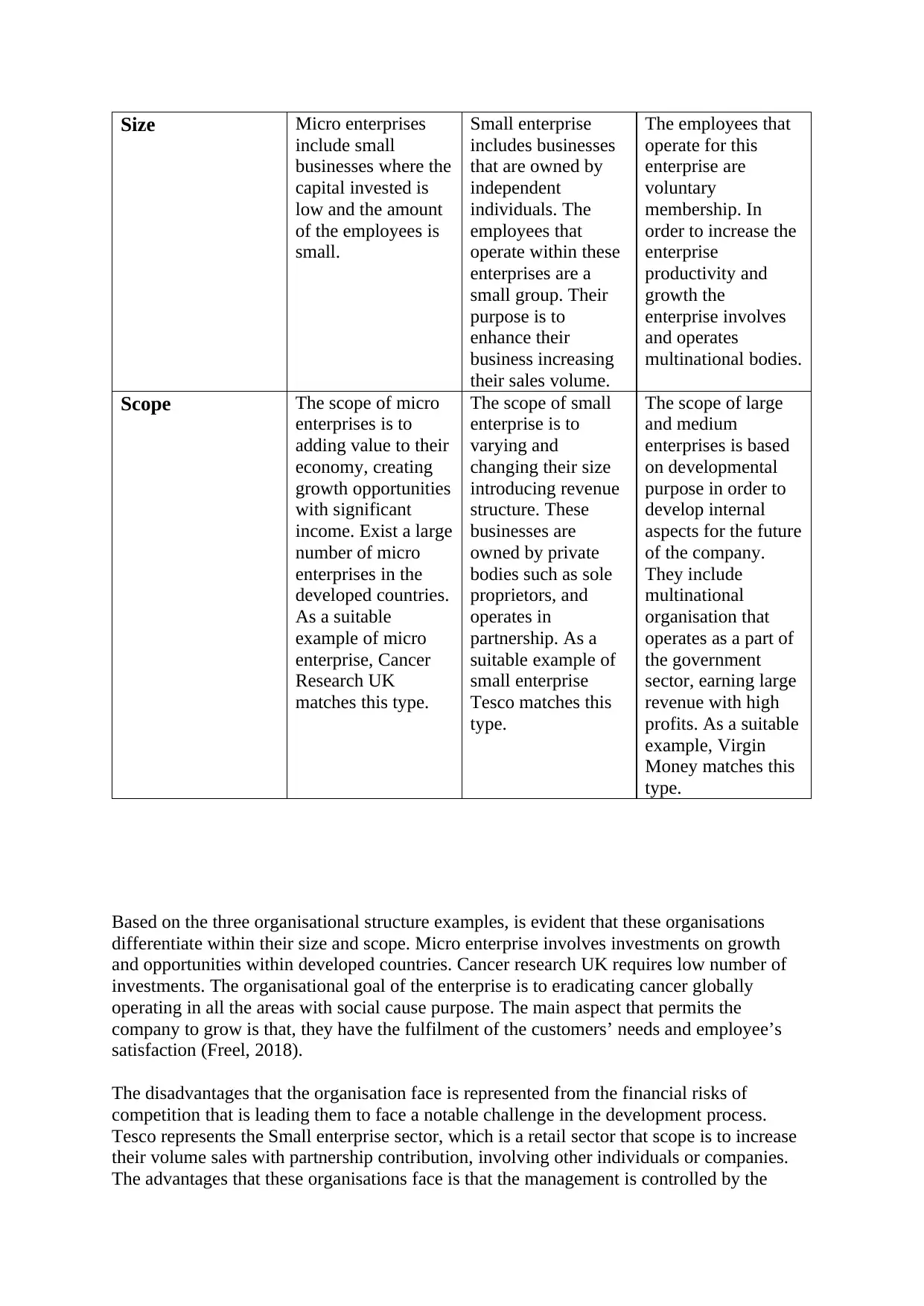
Size Micro enterprises
include small
businesses where the
capital invested is
low and the amount
of the employees is
small.
Small enterprise
includes businesses
that are owned by
independent
individuals. The
employees that
operate within these
enterprises are a
small group. Their
purpose is to
enhance their
business increasing
their sales volume.
The employees that
operate for this
enterprise are
voluntary
membership. In
order to increase the
enterprise
productivity and
growth the
enterprise involves
and operates
multinational bodies.
Scope The scope of micro
enterprises is to
adding value to their
economy, creating
growth opportunities
with significant
income. Exist a large
number of micro
enterprises in the
developed countries.
As a suitable
example of micro
enterprise, Cancer
Research UK
matches this type.
The scope of small
enterprise is to
varying and
changing their size
introducing revenue
structure. These
businesses are
owned by private
bodies such as sole
proprietors, and
operates in
partnership. As a
suitable example of
small enterprise
Tesco matches this
type.
The scope of large
and medium
enterprises is based
on developmental
purpose in order to
develop internal
aspects for the future
of the company.
They include
multinational
organisation that
operates as a part of
the government
sector, earning large
revenue with high
profits. As a suitable
example, Virgin
Money matches this
type.
Based on the three organisational structure examples, is evident that these organisations
differentiate within their size and scope. Micro enterprise involves investments on growth
and opportunities within developed countries. Cancer research UK requires low number of
investments. The organisational goal of the enterprise is to eradicating cancer globally
operating in all the areas with social cause purpose. The main aspect that permits the
company to grow is that, they have the fulfilment of the customers’ needs and employee’s
satisfaction (Freel, 2018).
The disadvantages that the organisation face is represented from the financial risks of
competition that is leading them to face a notable challenge in the development process.
Tesco represents the Small enterprise sector, which is a retail sector that scope is to increase
their volume sales with partnership contribution, involving other individuals or companies.
The advantages that these organisations face is that the management is controlled by the
include small
businesses where the
capital invested is
low and the amount
of the employees is
small.
Small enterprise
includes businesses
that are owned by
independent
individuals. The
employees that
operate within these
enterprises are a
small group. Their
purpose is to
enhance their
business increasing
their sales volume.
The employees that
operate for this
enterprise are
voluntary
membership. In
order to increase the
enterprise
productivity and
growth the
enterprise involves
and operates
multinational bodies.
Scope The scope of micro
enterprises is to
adding value to their
economy, creating
growth opportunities
with significant
income. Exist a large
number of micro
enterprises in the
developed countries.
As a suitable
example of micro
enterprise, Cancer
Research UK
matches this type.
The scope of small
enterprise is to
varying and
changing their size
introducing revenue
structure. These
businesses are
owned by private
bodies such as sole
proprietors, and
operates in
partnership. As a
suitable example of
small enterprise
Tesco matches this
type.
The scope of large
and medium
enterprises is based
on developmental
purpose in order to
develop internal
aspects for the future
of the company.
They include
multinational
organisation that
operates as a part of
the government
sector, earning large
revenue with high
profits. As a suitable
example, Virgin
Money matches this
type.
Based on the three organisational structure examples, is evident that these organisations
differentiate within their size and scope. Micro enterprise involves investments on growth
and opportunities within developed countries. Cancer research UK requires low number of
investments. The organisational goal of the enterprise is to eradicating cancer globally
operating in all the areas with social cause purpose. The main aspect that permits the
company to grow is that, they have the fulfilment of the customers’ needs and employee’s
satisfaction (Freel, 2018).
The disadvantages that the organisation face is represented from the financial risks of
competition that is leading them to face a notable challenge in the development process.
Tesco represents the Small enterprise sector, which is a retail sector that scope is to increase
their volume sales with partnership contribution, involving other individuals or companies.
The advantages that these organisations face is that the management is controlled by the
Paraphrase This Document
Need a fresh take? Get an instant paraphrase of this document with our AI Paraphraser
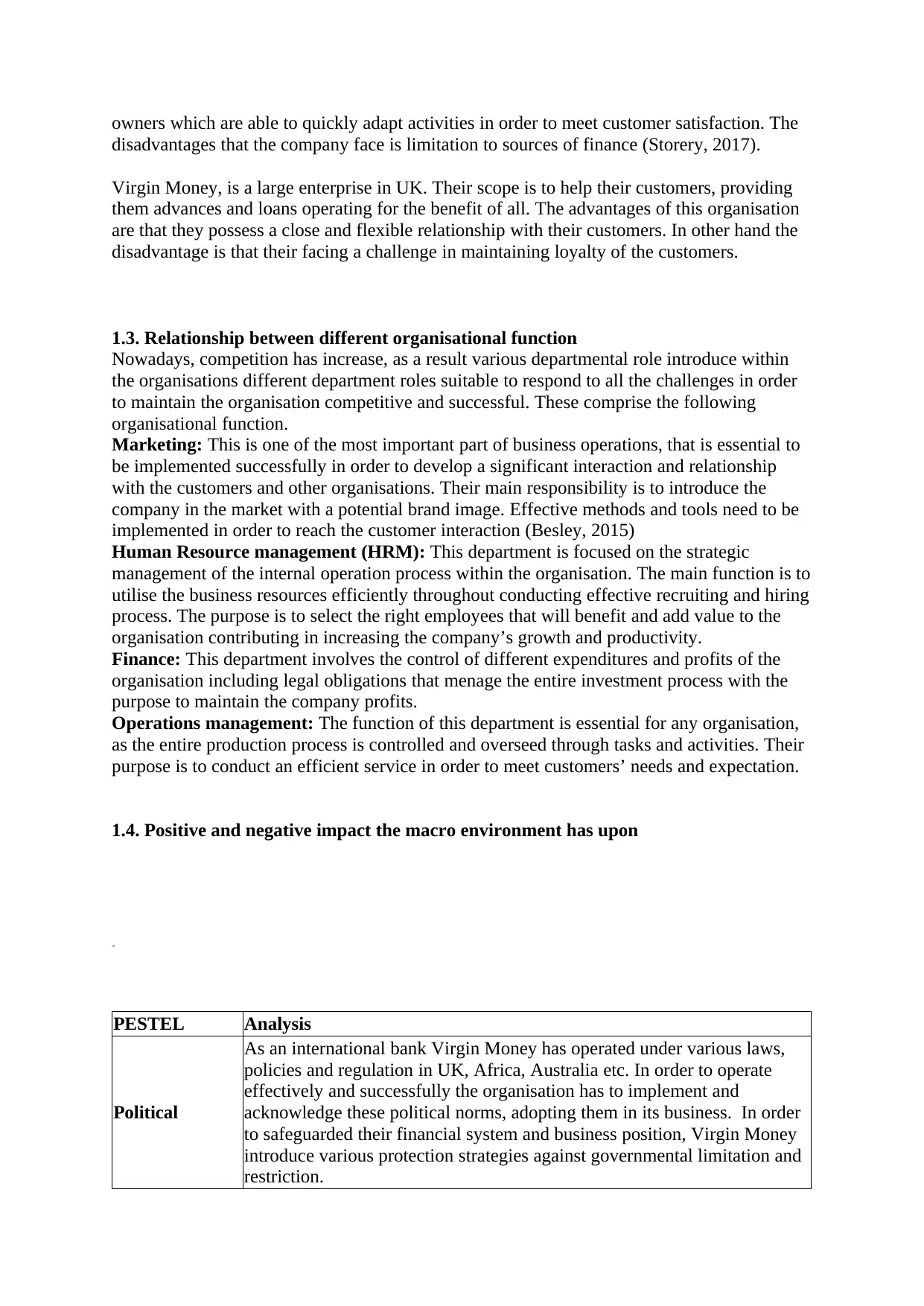
owners which are able to quickly adapt activities in order to meet customer satisfaction. The
disadvantages that the company face is limitation to sources of finance (Storery, 2017).
Virgin Money, is a large enterprise in UK. Their scope is to help their customers, providing
them advances and loans operating for the benefit of all. The advantages of this organisation
are that they possess a close and flexible relationship with their customers. In other hand the
disadvantage is that their facing a challenge in maintaining loyalty of the customers.
1.3. Relationship between different organisational function
Nowadays, competition has increase, as a result various departmental role introduce within
the organisations different department roles suitable to respond to all the challenges in order
to maintain the organisation competitive and successful. These comprise the following
organisational function.
Marketing: This is one of the most important part of business operations, that is essential to
be implemented successfully in order to develop a significant interaction and relationship
with the customers and other organisations. Their main responsibility is to introduce the
company in the market with a potential brand image. Effective methods and tools need to be
implemented in order to reach the customer interaction (Besley, 2015)
Human Resource management (HRM): This department is focused on the strategic
management of the internal operation process within the organisation. The main function is to
utilise the business resources efficiently throughout conducting effective recruiting and hiring
process. The purpose is to select the right employees that will benefit and add value to the
organisation contributing in increasing the company’s growth and productivity.
Finance: This department involves the control of different expenditures and profits of the
organisation including legal obligations that menage the entire investment process with the
purpose to maintain the company profits.
Operations management: The function of this department is essential for any organisation,
as the entire production process is controlled and overseed through tasks and activities. Their
purpose is to conduct an efficient service in order to meet customers’ needs and expectation.
1.4. Positive and negative impact the macro environment has upon
PESTEL Analysis
Political
As an international bank Virgin Money has operated under various laws,
policies and regulation in UK, Africa, Australia etc. In order to operate
effectively and successfully the organisation has to implement and
acknowledge these political norms, adopting them in its business. In order
to safeguarded their financial system and business position, Virgin Money
introduce various protection strategies against governmental limitation and
restriction.
disadvantages that the company face is limitation to sources of finance (Storery, 2017).
Virgin Money, is a large enterprise in UK. Their scope is to help their customers, providing
them advances and loans operating for the benefit of all. The advantages of this organisation
are that they possess a close and flexible relationship with their customers. In other hand the
disadvantage is that their facing a challenge in maintaining loyalty of the customers.
1.3. Relationship between different organisational function
Nowadays, competition has increase, as a result various departmental role introduce within
the organisations different department roles suitable to respond to all the challenges in order
to maintain the organisation competitive and successful. These comprise the following
organisational function.
Marketing: This is one of the most important part of business operations, that is essential to
be implemented successfully in order to develop a significant interaction and relationship
with the customers and other organisations. Their main responsibility is to introduce the
company in the market with a potential brand image. Effective methods and tools need to be
implemented in order to reach the customer interaction (Besley, 2015)
Human Resource management (HRM): This department is focused on the strategic
management of the internal operation process within the organisation. The main function is to
utilise the business resources efficiently throughout conducting effective recruiting and hiring
process. The purpose is to select the right employees that will benefit and add value to the
organisation contributing in increasing the company’s growth and productivity.
Finance: This department involves the control of different expenditures and profits of the
organisation including legal obligations that menage the entire investment process with the
purpose to maintain the company profits.
Operations management: The function of this department is essential for any organisation,
as the entire production process is controlled and overseed through tasks and activities. Their
purpose is to conduct an efficient service in order to meet customers’ needs and expectation.
1.4. Positive and negative impact the macro environment has upon
PESTEL Analysis
Political
As an international bank Virgin Money has operated under various laws,
policies and regulation in UK, Africa, Australia etc. In order to operate
effectively and successfully the organisation has to implement and
acknowledge these political norms, adopting them in its business. In order
to safeguarded their financial system and business position, Virgin Money
introduce various protection strategies against governmental limitation and
restriction.
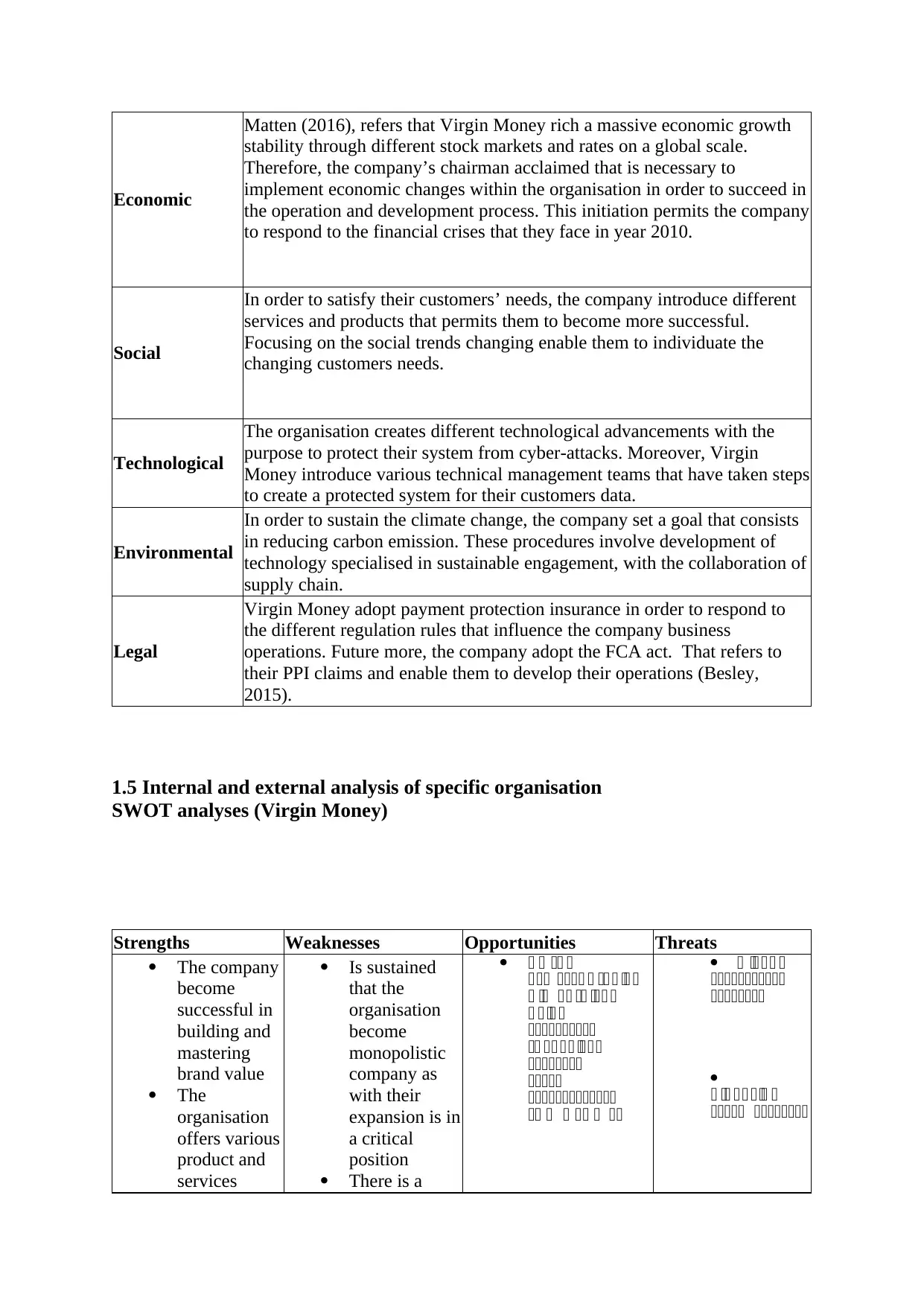
Economic
Matten (2016), refers that Virgin Money rich a massive economic growth
stability through different stock markets and rates on a global scale.
Therefore, the company’s chairman acclaimed that is necessary to
implement economic changes within the organisation in order to succeed in
the operation and development process. This initiation permits the company
to respond to the financial crises that they face in year 2010.
Social
In order to satisfy their customers’ needs, the company introduce different
services and products that permits them to become more successful.
Focusing on the social trends changing enable them to individuate the
changing customers needs.
Technological
The organisation creates different technological advancements with the
purpose to protect their system from cyber-attacks. Moreover, Virgin
Money introduce various technical management teams that have taken steps
to create a protected system for their customers data.
Environmental
In order to sustain the climate change, the company set a goal that consists
in reducing carbon emission. These procedures involve development of
technology specialised in sustainable engagement, with the collaboration of
supply chain.
Legal
Virgin Money adopt payment protection insurance in order to respond to
the different regulation rules that influence the company business
operations. Future more, the company adopt the FCA act. That refers to
their PPI claims and enable them to develop their operations (Besley,
2015).
1.5 Internal and external analysis of specific organisation
SWOT analyses (Virgin Money)
Strengths Weaknesses Opportunities Threats
The company
become
successful in
building and
mastering
brand value
The
organisation
offers various
product and
services
Is sustained
that the
organisation
become
monopolistic
company as
with their
expansion is in
a critical
position
There is a
A A AA A
AAA AAAA A AAA AAA
A AA AA AA AAA A
A AAA A
AAAAAAAAAA
AA AAAA AAAA
AAAAAAAA
AAAAA
AAAAAAAAAAAAA
AA A A AA A AA
A AAAA A
AAAAAAAAAAA
AAAAAAAA
A AA AAAAA A
AAAAA AAAAAAAA
Matten (2016), refers that Virgin Money rich a massive economic growth
stability through different stock markets and rates on a global scale.
Therefore, the company’s chairman acclaimed that is necessary to
implement economic changes within the organisation in order to succeed in
the operation and development process. This initiation permits the company
to respond to the financial crises that they face in year 2010.
Social
In order to satisfy their customers’ needs, the company introduce different
services and products that permits them to become more successful.
Focusing on the social trends changing enable them to individuate the
changing customers needs.
Technological
The organisation creates different technological advancements with the
purpose to protect their system from cyber-attacks. Moreover, Virgin
Money introduce various technical management teams that have taken steps
to create a protected system for their customers data.
Environmental
In order to sustain the climate change, the company set a goal that consists
in reducing carbon emission. These procedures involve development of
technology specialised in sustainable engagement, with the collaboration of
supply chain.
Legal
Virgin Money adopt payment protection insurance in order to respond to
the different regulation rules that influence the company business
operations. Future more, the company adopt the FCA act. That refers to
their PPI claims and enable them to develop their operations (Besley,
2015).
1.5 Internal and external analysis of specific organisation
SWOT analyses (Virgin Money)
Strengths Weaknesses Opportunities Threats
The company
become
successful in
building and
mastering
brand value
The
organisation
offers various
product and
services
Is sustained
that the
organisation
become
monopolistic
company as
with their
expansion is in
a critical
position
There is a
A A AA A
AAA AAAA A AAA AAA
A AA AA AA AAA A
A AAA A
AAAAAAAAAA
AA AAAA AAAA
AAAAAAAA
AAAAA
AAAAAAAAAAAAA
AA A A AA A AA
A AAAA A
AAAAAAAAAAA
AAAAAAAA
A AA AAAAA A
AAAAA AAAAAAAA
⊘ This is a preview!⊘
Do you want full access?
Subscribe today to unlock all pages.

Trusted by 1+ million students worldwide
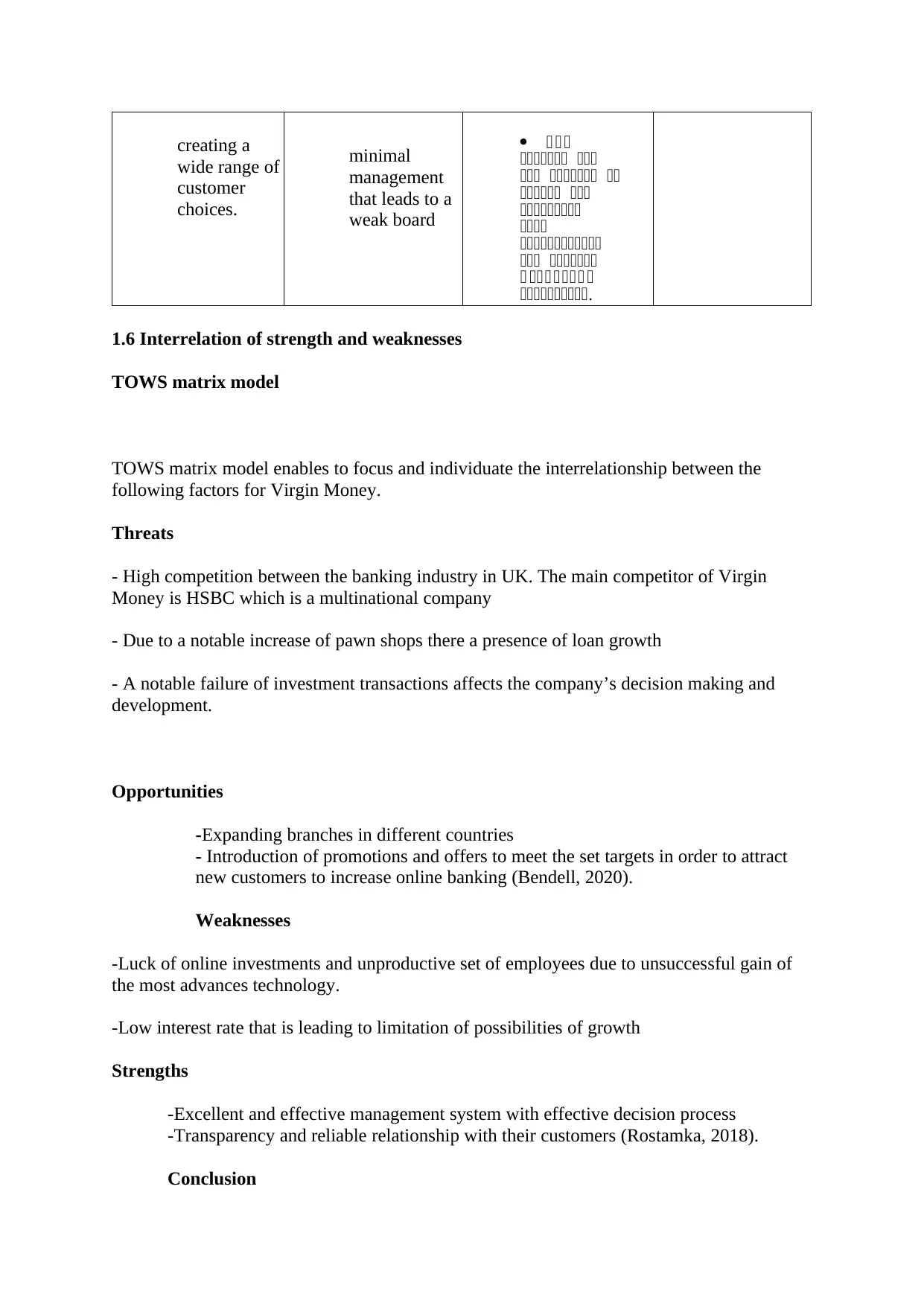
creating a
wide range of
customer
choices.
minimal
management
that leads to a
weak board
A A A
AAAAAAA AAA
AAA AAAAAAA AA
AAAAAA AAA
AAAAAAAAA
AAAA
AAAAAAAAAAAA
AAA AAAAAAA
A AAAAAAA A
AAAAAAAAAA.
1.6 Interrelation of strength and weaknesses
TOWS matrix model
TOWS matrix model enables to focus and individuate the interrelationship between the
following factors for Virgin Money.
Threats
- High competition between the banking industry in UK. The main competitor of Virgin
Money is HSBC which is a multinational company
- Due to a notable increase of pawn shops there a presence of loan growth
- A notable failure of investment transactions affects the company’s decision making and
development.
Opportunities
-Expanding branches in different countries
- Introduction of promotions and offers to meet the set targets in order to attract
new customers to increase online banking (Bendell, 2020).
Weaknesses
-Luck of online investments and unproductive set of employees due to unsuccessful gain of
the most advances technology.
-Low interest rate that is leading to limitation of possibilities of growth
Strengths
-Excellent and effective management system with effective decision process
-Transparency and reliable relationship with their customers (Rostamka, 2018).
Conclusion
wide range of
customer
choices.
minimal
management
that leads to a
weak board
A A A
AAAAAAA AAA
AAA AAAAAAA AA
AAAAAA AAA
AAAAAAAAA
AAAA
AAAAAAAAAAAA
AAA AAAAAAA
A AAAAAAA A
AAAAAAAAAA.
1.6 Interrelation of strength and weaknesses
TOWS matrix model
TOWS matrix model enables to focus and individuate the interrelationship between the
following factors for Virgin Money.
Threats
- High competition between the banking industry in UK. The main competitor of Virgin
Money is HSBC which is a multinational company
- Due to a notable increase of pawn shops there a presence of loan growth
- A notable failure of investment transactions affects the company’s decision making and
development.
Opportunities
-Expanding branches in different countries
- Introduction of promotions and offers to meet the set targets in order to attract
new customers to increase online banking (Bendell, 2020).
Weaknesses
-Luck of online investments and unproductive set of employees due to unsuccessful gain of
the most advances technology.
-Low interest rate that is leading to limitation of possibilities of growth
Strengths
-Excellent and effective management system with effective decision process
-Transparency and reliable relationship with their customers (Rostamka, 2018).
Conclusion
Paraphrase This Document
Need a fresh take? Get an instant paraphrase of this document with our AI Paraphraser
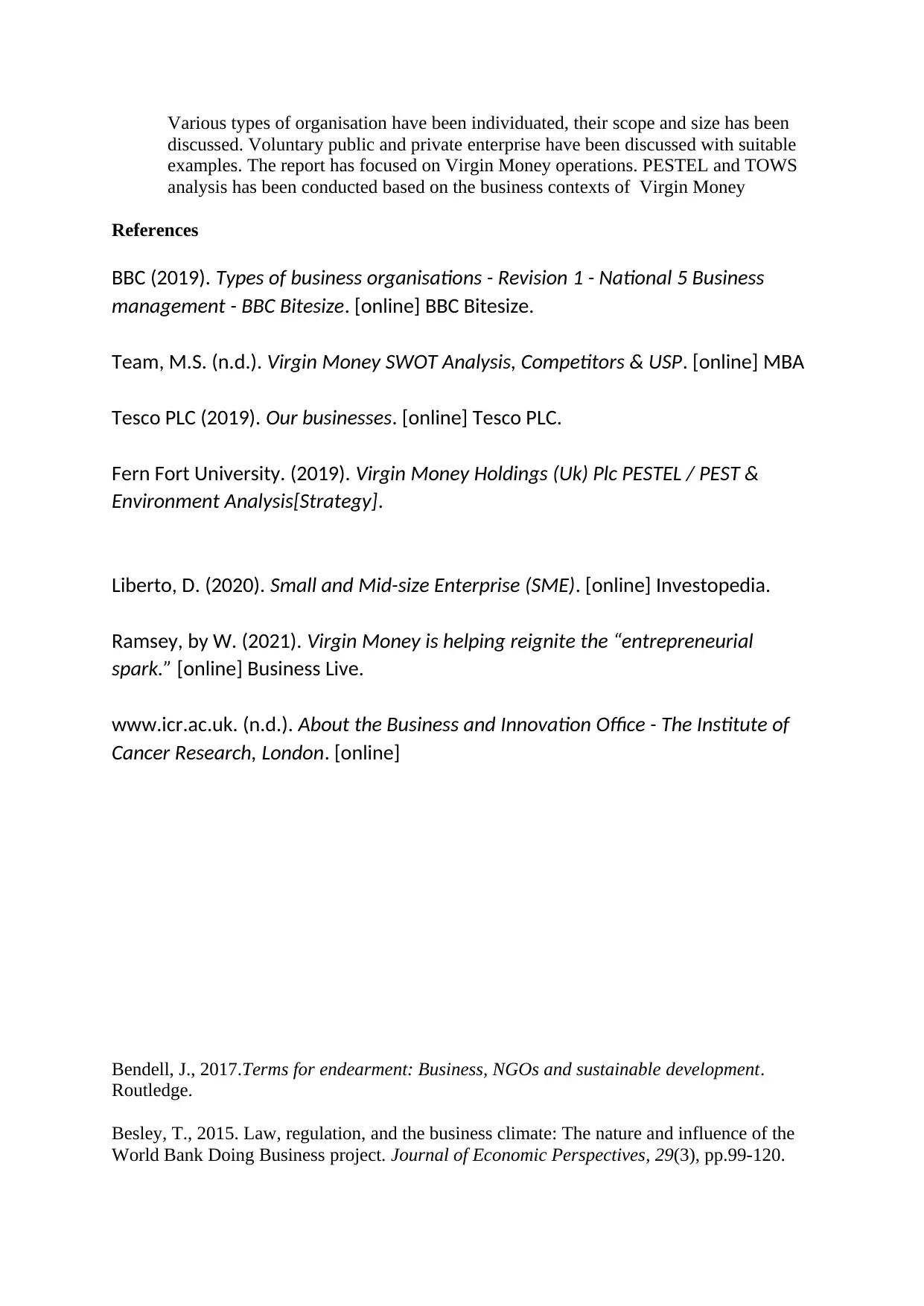
Various types of organisation have been individuated, their scope and size has been
discussed. Voluntary public and private enterprise have been discussed with suitable
examples. The report has focused on Virgin Money operations. PESTEL and TOWS
analysis has been conducted based on the business contexts of Virgin Money
References
BBC (2019). Types of business organisations - Revision 1 - National 5 Business
management - BBC Bitesize. [online] BBC Bitesize.
Team, M.S. (n.d.). Virgin Money SWOT Analysis, Competitors & USP. [online] MBA
Tesco PLC (2019). Our businesses. [online] Tesco PLC.
Fern Fort University. (2019). Virgin Money Holdings (Uk) Plc PESTEL / PEST &
Environment Analysis[Strategy].
Liberto, D. (2020). Small and Mid-size Enterprise (SME). [online] Investopedia.
Ramsey, by W. (2021). Virgin Money is helping reignite the “entrepreneurial
spark.” [online] Business Live.
www.icr.ac.uk. (n.d.). About the Business and Innovation Office - The Institute of
Cancer Research, London. [online]
Bendell, J., 2017.Terms for endearment: Business, NGOs and sustainable development.
Routledge.
Besley, T., 2015. Law, regulation, and the business climate: The nature and influence of the
World Bank Doing Business project. Journal of Economic Perspectives, 29(3), pp.99-120.
discussed. Voluntary public and private enterprise have been discussed with suitable
examples. The report has focused on Virgin Money operations. PESTEL and TOWS
analysis has been conducted based on the business contexts of Virgin Money
References
BBC (2019). Types of business organisations - Revision 1 - National 5 Business
management - BBC Bitesize. [online] BBC Bitesize.
Team, M.S. (n.d.). Virgin Money SWOT Analysis, Competitors & USP. [online] MBA
Tesco PLC (2019). Our businesses. [online] Tesco PLC.
Fern Fort University. (2019). Virgin Money Holdings (Uk) Plc PESTEL / PEST &
Environment Analysis[Strategy].
Liberto, D. (2020). Small and Mid-size Enterprise (SME). [online] Investopedia.
Ramsey, by W. (2021). Virgin Money is helping reignite the “entrepreneurial
spark.” [online] Business Live.
www.icr.ac.uk. (n.d.). About the Business and Innovation Office - The Institute of
Cancer Research, London. [online]
Bendell, J., 2017.Terms for endearment: Business, NGOs and sustainable development.
Routledge.
Besley, T., 2015. Law, regulation, and the business climate: The nature and influence of the
World Bank Doing Business project. Journal of Economic Perspectives, 29(3), pp.99-120.

⊘ This is a preview!⊘
Do you want full access?
Subscribe today to unlock all pages.

Trusted by 1+ million students worldwide
1 out of 9
Related Documents
Your All-in-One AI-Powered Toolkit for Academic Success.
+13062052269
info@desklib.com
Available 24*7 on WhatsApp / Email
![[object Object]](/_next/static/media/star-bottom.7253800d.svg)
Unlock your academic potential
Copyright © 2020–2025 A2Z Services. All Rights Reserved. Developed and managed by ZUCOL.





